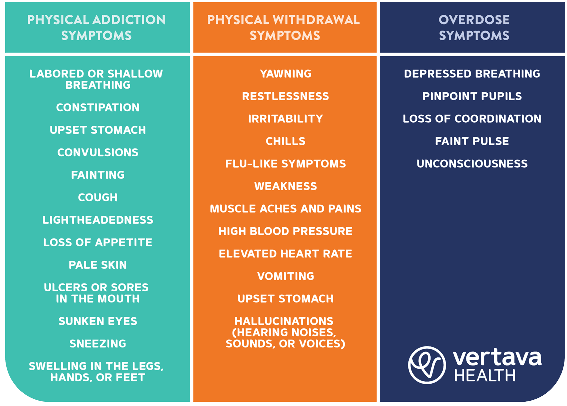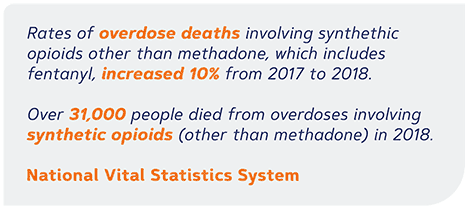There’s a reason why the U.S. Drug Enforcement Administration has a resource manual for slang terms and code words, which is evident from the above list distributed to law enforcement personnel. This list comes out and is almost out-of-date as soon as it hits the streets. It’s a list where “Fenty” does not mean a designer fashion from Rhianna and “Tango and Cash” is definitely not the 1989 movie featuring Sylvester Stallone and Kurt Russell.
Having slang names makes the drug seem more fun and less medical. It can also be used to divert someone from what is really being talked about. Illicit drug use.
The Path Of Fentanyl To Addiction
As anyone can tell you once they’ve gone through the addiction and found themselves on the other side eventually to recovery, they never imagined with that first experience, what a complicated road they were going down. And there was no handbook given to guide them—or you—through the experience fraught with perils unimaginable to someone looking on from outside.
Can you just imagine the book’s name? How to Use Fentanyl Safely While Drinking, Not Working, and No $$. That would either be a bestseller on The New York Times list or a bust, which is the same description we could give your journey with fentanyl and its many, many side effects.
Let’s delve a little deeper. That way, if you are considering getting treatment yourself or looking for treatment for a loved one, you can understand the cognitive and physical toll each day of fentanyl use is exacting upon your body.
It’s an extremely long list of both short- and long-term side effects, some enjoyable and some unpleasant. Adding to that list are signs someone is using fentanyl or signs indicating an overdose.
Why Do People Take Fentanyl?
Main reasons people list for using fentanyl:
- Excessive happiness
- A deep sense of relaxation
- Pain relief (pharmaceutical fentanyl is administered for cancer patients)
- Unknowingly given
Seeking a way to relax or find excessive happiness are reasons people may seek the drug or stumble across just experimenting while using. Liking the effect they receive, they again take it after it wears off. Sometimes this is short-term and for others too often turns into the only way they can maintain this state of happiness. Escaping their problems with the chemical high becomes routine.
Pain relief, while not as common, is another reason someone uses fentanyl. Pharmaceutical fentanyl is a Schedule II controlled substance approved for use to treat severe pain, most often experienced by those in pain from advanced cancer. It is 50 to 100 times more potent than morphine and administered as transdermal pain patches or lozenges, according to the Centers for Disease Control and Prevention (CDC). This legal form has been misused by others when they have access to it.
Unknowingly taking another drug that is laced with fentanyl is increasingly common. A single dosage of fentanyl generally could cause life-threatening respiratory depression and overdose on fentanyl. This is leading to overdoses and emergency room visits because breathing has slowed or stopped. Once treated with naloxone (common brand name NARCAN®), normal respiration is restored, the person is revived, and often disappears back to the streets.
There are multiple versions of naloxone and many treatment centers, first responders, and even fentanyl users themselves have become well-aware of how to administer the drug. Oftentimes, the overdose is shrugged off by the person who is administered to as just something to get through, then back to using fentanyl.
Whether it is to relax or mistakenly taken, even in the short term, fentanyl can be very dangerous. The National Vital Statistics System expands upon the overdose above stating that fentanyl deaths saw a 1045% increase from 2012 to 2016.
Symptoms of fentanyl overdose include:
- Blue or purplish fingernails or lips
- Cold, clammy, and/or pale skin
- Gurgling noises
- A person’s body goes limp
- A person can’t speak
- Pinpoint pupils
- Slowed or stopped heartbeat
- Vomiting
These signs can bring a person’s health down a long, dark road.
Transdermal Patches And Other Forms of Dosage
Fentanyl is a human-made opioid created in a laboratory setting, often from China. It is sold as either a powder or a pill designed to appear like a prescription drug.
As a powder form, it is then dropped onto a small blotter paper and dissolved on the tongue, or placed in nasal sprays or eye droppers.
Because it is relatively inexpensive to produce, it may be added, or “cut in,” to another substance, for an increased impact. The person may take it knowingly or unknowingly, in which case an overdose would not be uncommon. These are counterfeit pills known by the slang words mentioned earlier.
Fentanyl has a high potential for misuse and can cause severe physical or psychological dependence. Because of its potency, fentanyl use can quickly develop to tolerance, addiction, or deadly overdose.
Pharmaceutically-produced fentanyl typically comes as a transdermal patch to treat chronic pain through time-released gel. If these patches are misused, to get the drug as a one-time high, a person will remove the gel and inject it intravenously.
How Long Does Fentanyl Dosage Last With Medical Use? What’s The Risk of Overdose?
Fentanyl is fast-acting and somewhat short-lived when compared to other drugs. It can take effect within minutes and last as short as a half hour or as long as one-and-a-half hours.
It is measured in micrograms (mcg) due to its potency and risk for overdose, even in small amounts. One dose in a hospital setting is 5 to 20 mcg, with an average of 10 mcg.
Short-Term Adverse Fentanyl Side Effects
Not every individual will experience the same side effects the same way, but some of the common short-term adverse effects, beyond the more pleasant feeling ones of fentanyl are:
- sedation
- confusion
- drowsiness
- dizziness
- nausea or vomiting
- difficulty urinating
- pinpoint pupils
- respiratory depression
Long-Term Fentanyl Physical Side Effects
Long-term use of fentanyl can lead to heart or respiratory problems. Further, people who inject fentanyl and share needles have an increased risk of contracting HIV/AIDS, hepatitis, or other infectious diseases.
How Can You Tell If Someone Is Taking Fentanyl?
Oftentimes in any friendship or family, somebody notices something isn’t quite right about somebody else but struggles to put a finger on exactly what’s different. Many times, studying someone’s behavior is the key and a nearly invisible tell-tale sign, or side effect if you will.
- Changes in routine. Perhaps your buddy always came by on Sundays to watch football or help on a house project. Now, you’re noticing he started canceling with excuses, then just stopped making excuses and now his regular seat sits empty on Sundays.
When he does come by, he’s moody, looks like he hasn’t showered in days, and claims he’s too tired to help you with weekend projects. - Psychological changes. On any given day, you might see your daughter display an entire spectrum of emotions and not know what to make of her behavior. She can find it hard to concentrate or remember things, seemingly lost in daydreams. Her mood will rapidly swing from paranoia to depression to anxiety to hallucinations. This altered personality state could lead her to make decisions while having impaired judgment.
- Physical changes. Perhaps it’s short-lived or seems to be chronically occurring. Does a friend of yours have a multitude of physical ailments you are visibly noticing? Here are common physical effects a person may have from using fentanyl or from withdrawal. Get comfortable and read slowly. It is a long list.

- Stealing money/drugs or doctor shopping. Multiple visits to the doctor is a classic indicator of doctor shopping. This occurs when someone seeks to get pain medication prescriptions and uses so frequently the refill schedule doesn’t satisfy their need to get more of the opioid. No problem. They just schedule a new appointment with a new physician’s office.
If this approach doesn’t work, the person may steal family member’s or friend’s prescriptions or money in order to purchase more fentanyl—or any opioid. - Serious life consequences. Perhaps your husband has lost his job or experienced an overdose and had to be treated at the emergency room, leaving promptly afterward saying he’s “just fine.”
Withdrawal Symptoms For Fentanyl
Opioid withdrawal symptoms are listed in the chart above and include the following. These can begin any time up to one-and-a-half days after last fentanyl use:
- Excessive sweating
- Insomnia
- Flu-like muscle aches or pain in bones
- Anxiousness
- Stomach cramping or diarrhea
- Nausea or vomiting
- Runny nose
- Drug craving
It can take weeks before you might experience normal health after the first days of discomfort. It is extremely important to check in with your doctor or a treatment center prior to detox so your condition can be medically monitored. It is also helpful to have a medical provider supervise you who can make medications to treat you and avoid relapse due to discomfort.
Treatment From Fentanyl Addiction Toward Better Health
Breaking the cycle of fentanyl addiction is possible with comprehensive treatment. By choosing treatment for fentanyl addiction, a person is given an opportunity for a healthier, drug-free life. An inpatient withdrawal management program, otherwise known as inpatient detox, may be necessary for people who are moderate to severely addicted to fentanyl.
Symptoms of fentanyl withdrawal can become extreme. Paired with intense cravings, these states may push a person to relapse as they try to reduce withdrawal symptoms.
Vertava Health offers a residential medical detox program providing 24-hour oversight and medical care, support that can be a critical component of reducing the risk of relapse and improving success at this time. Addiction never takes a day off and neither do we. We’re here for you 24/7 and invite you to call 844-470-0410 to learn more.
Frequently Asked Questions:
What Are The Side Effects Of Fentanyl?
Fentanyl has physical and psychological side effects you can see, such as nausea or vomiting, dizziness, stomach pain, sedation, confusion or disorientation, unconsciousness, constipation, dry mouth, trouble breathing, confusion, difficulty concentrating, moodiness, and hallucinations.
After Using Fentanyl, How Long Do Side Effects Last?
The euphoria high generally lasts for up to two hours after the initial dose.
How Do I Taper Off Fentanyl Pain Patches Without Side Effects?
If the patches were medically prescribed, tapering is rare because it was prescribed due to chronic pain. If the pain patches were taken and used by someone it was not prescribed for, that person might be unable to keep an inventory and must taper off as supply level dwindles, or they wish to cease use.






